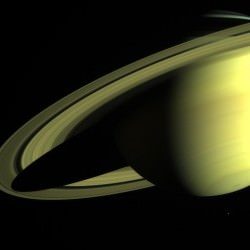Saturn has fascinated amateurs and professionals alike for centuries. As quickly as the planet’s ring system was discovered the popular question became ‘why does Saturn have rings?’ usually followed by ‘what are Saturn’s rings made of?’. Well, here are the answers to both questions.
The simplest answer as to why Saturn has rings and what they are made of is that the planet has accumulated a great deal of dust, particles, and ice at varying distances from its surface. These items are most likely trapped by gravity. The rings appear because of the wavelengths of light reflected by these rings of debris.
Some scientists speculate that Saturn may be too big. Its gravitational pull is so strong that it has been able to snatch debris from space. Some of which is as large as an entire building. That pull is why it has at least 62 moons. Those moons contribute dust to the rings as well as absorb dust from the rings.
A common theory as to how all of the material initially accumulated in Saturn’s rings is a series of asteroid impacts. Not with the planet, but with the moons around it. After the impact the remnants of the asteroids and the debris from the moons could not escape the gravitational pull of the planet.
One other theory holds that the rings of Saturn formed as other moons broke apart in ancient times. Additionally, this theory states that some of the material could be from earlier, during the formation of the solar system, and Saturn could not accrete the material while it was forming and it has been in orbit ever since.
No matter which theory you believe, the rings of Saturn are spectacular. After researching Saturn’s rings a little more, be sure to investigate the ring systems around Neptune, Uranus, and Jupiter. Each system is fainter than Saturn’s, but still interesting.
We have written many articles about Saturn for Universe Today. Here’s an article about the color of Saturn, and here are some pictures of Saturn.
If you’d like more info on Saturn, check out Hubblesite’s News Releases about Saturn. And here’s a link to the homepage of NASA’s Cassini spacecraft, which is orbiting Saturn.
We’ve also recorded an episode of Astronomy Cast all about Saturn. Listen here, Episode 59: Saturn.
Reference:
NASA

